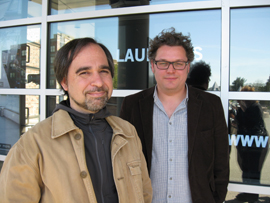First you hear voices. A jumble of conversation, with one voice rising above the rest. Then you see large monitors streaming the words being spoken, along with videos. You notice that the people in the videos are your gender and approximate age. The text sounds vaguely like something you might post on Facebook.
What the heck?
You’ve just encountered Sanctum, an interactive public artwork created by Juan Pampin and James Coupe, faculty in the UW’s Digital Arts and Experimental Media (DXARTS) Program. The artwork, commissioned by theHenry Art Gallery, will be on view outside the Henry’s main entrance through November 2015. Sanctum was selected through an international, juried competition with more than 90 entries.
The provocative work offers brief, ever-changing narratives—as short as a few seconds, as long as two minutes—presented on 18 LCD monitors using text, images, and audio. The cycle begins when surveillance cameras capture the face of a passing pedestrian. Facial recognition software identifies the individual’s gender and approximate age; the monitor then displays images and Facebook status updates from people in the same demographic. An audio version of those updates airs through ultrasonic speakers. “The public becomes the content in a public piece,” says Coupe, “where usually they are just observers.”

Although Sanctum uses complex technology, most of it will be invisible to viewers. “It’s all integrated into the experience,” says Pampin, director of DXARTS. The status updates are selected and combined to create “fictional narratives” using an algorithm that identifies sentence-like grammar and shared keywords. The audio version of the narratives, created through text-to-speech software, is delivered via an ultrasound beam that follows the profiled individual as he or she walks past. “Developing this has been a huge research project,” says Pampin. “A piece like this couldn’t be done without a place like DXARTS. It’s not something that could be produced by one artist in a studio.”
The artists are aware that the profiling aspect of the artwork may both intrigue and concern viewers. They explain that this dichotomy is central to the piece, reflecting how our culture embraces ever-more-intrusive electronic media while still cherishing traditional notions of privacy.
A lot of people—particularly younger generations—want to be on camera. They want to be seen. But the question is, when do they want to be seen? When do they want to approach the screens and be profiled and see what narratives come up, and when do they want to step back?”
“Social media like YouTube, Facebook, and Twitter are all forms of self surveillance,” explains Coupe. “A lot of people—particularly younger generations—want to be on camera. They want to be seen. But the question is,when do they want to be seen? When do they want to approach the screens and be profiled and see what narratives come up, and when do they want to step back?”
In reality, passersby will only be profiled if they look into one of the installed cameras for a few seconds, as explained in signage near each camera. And the displayed text is from Facebook users who have volunteered as contributors, using a sign-up form found on the Sanctum and Henry Art Gallery websites. All Facebook entries are anonymous, categorized only by age and gender. Every 90 days, contributors are given the option to continue or end their participation.
“The fact that we are using actual Facebook posts in real time is important,” says Coupe. “If there is a world-changing event, that will be reflected in the piece. Even more familiar events—Christmas, for example—will be reflected in posts at that time. It lets people know that the posts are real, rather than a pre-packaged representation of something.”
The Henry and the artists went to great lengths to ensure that Sanctum respects privacy rights. “When we started putting our proposal together, we knew we had to have all our legal ducks in a row,” says Coupe. “The School of Law had produced a memorandum a few years earlier about legal issues in using surveillance in artwork. That answered many of our questions, but we had the UW Entrepreneurial Law Clinic review our plans, just to be sure. Later we worked with the UW Office of Risk Management as we made decisions about things like signage and locations of cameras, to minimize risk regarding privacy. We had to wait until they rubber-stamped our plans before we could move forward.”

The artists credit the Henry for its willingness to take on the project, acknowledging that while the gallery is known for taking artistic risks, Sanctum has tested other boundaries as well. The Henry is currently planning programming around Sanctum for the fall.
Since Sanctum went live on May 4, Pampin and Coupe have enjoyed observing how people respond to the artwork. They assume that viewer interaction will change as people become more familiar with the piece. “We want Sanctum to evolve,” says Pampin. “We have many ideas of what the piece could do, but first we want to see how people react to it.”
Adds Coupe, “It’s an intimate experience in a public space with something that people don’t completely understand. And, hopefully, that will keep bringing them back.”
For more information about Sanctum, including how you can share your Facebook status updates for use in the artwork, visit the Sanctum website.
More Stories

Bringing Music to Life Through Audio Engineering
UW School of Music alum Andrea Roberts, an audio engineer, has worked with recording artists in a wide range of genres — including Beyoncé.

A Healing Heart Returns
In February, the UW Symphony will perform a symphony that Coast Salish elder Vi Hilbert commissioned years ago to heal the world after the heartbreak of 9/11. The symphony was first performed by the Seattle Symphony in 2006.

Need a break from holiday movies? Try these
For those wanting a break from holiday movies, Cinema & Media Studies faculty and grad students offer suggestions.